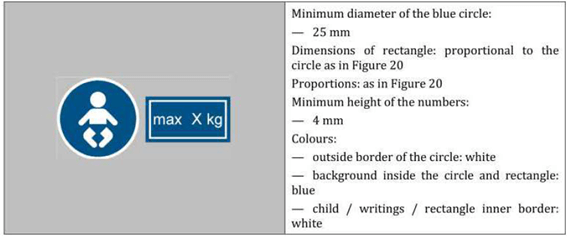EU publishes updated standard for Carry Cots
Vol. 1368 | 10 Aug 2023
European Standard EN 1466:2023 Carry Cots and Stands for Domestic Use has been published recently. It supersedes the old standard (EN 1466:2014+AC 2015 which is still harmonized under GPSD) latest by June 2024.
This updated document includes a number of significant technical changes as follows:
- Define a clear scope and cover those carry cots for carrying a child in a lying position by means of handle(s) by using one hand and intended for domestic use.
- Add/update new chemical requirements in Cl 6.2 Chemical Hazards:
- Migration of certain elements per EN 71-3:2019 +A1:2021
- Formaldehyde per EN ISO 14184-1:2011
- Colorants per EN 71-10:2005
- Update the standard reference in Thermal Hazard (Cl 6.3) by referring EN 71-2:2020, clause 5.4 for surface flash and clearly include the flame propagation rate (≤ 50mm/s) in the same test.
- Improve the layout in testing the effectiveness of the retaining function of the sides of non-rigid carry cots (Cl 7.1.2.3)
- Outline the test methods on the sides and ends of the non-rigid carry cot
- Clarify the orientation of the 9 kg test mass when placing in the geometric centre of the carry cot (its long axis should be parallel to the longer side of the carry cot)
- Introduce a new test sphere (Cl 5.11, 5 kg and dia 120mm) in testing the ends of non-rigid carry cots (7.1.2.4)
- Editorial changes in clause 7.1.5 Restraint system
- Additional requirement and test method for internal lining made of fabric in Cl 7.6 Suffocation hazard. Such a lining shall be designed and tensioned so not to present any suffocation hazard to the occupant.
- Revise the layout and clarity in Cl 7.8.3 Stability tests with the following key changes:
- Improve the diagram in the stability on the inclined plane by the addition of the stopper as required by the standard
- Define the location where the maximum angle of inclination should be determined in longitudinal stability of carry cots
- Remove the dummy box (3 kg) and replaced by “a compatible carry cot in accordance with the stand manufacturer’s instructions”
- Revise and improve the strength tests of carry cots and stands in Cl 7.9.3 and 7.9.4 :
- Add the requirement for those carry cot with more than one flexible carrying handle
- A complete new requirements in the strength of carrying handle(s) locking mechanism(s)
- Remove the dummy box (3 kg) but use the compatible carry cot according to the manufacturer’s instruction when testing the strength of stands
- Product information per Cl 9:
- Set the minimum font height (2.5mm) for warning sentences
- Define web page as the point of sales if the product is sold on internet
- The following pictogram shall be accompanied by the statement “This product is suitable only for a child who cannot sit up unaided, roll over and cannot push itself up on its hands and knees. Maximum weight of the child: 9 kg."

Note – this requirement does not apply to products complying with ECE 44/R129. - The marking for non-rigid carry cot shall have the warning “WARNING: Never leave the child unattended” and shall be accompanied by the following graphical symbol:

- Other editorial changes in clause 9.4 Instructions for use and maintenance for carry cot and/or stand
- Add Annex ZA to cover the relationship between this EN standard and the safety requirements of GPSD 2001/95/EC
If you have any questions, please contact our technical expert John Ng (john.ng@intertek.com).